Australia So Much to See


Western Australia 2008. We explore goldfields history in the outback Murchison featuring Sandstone.
We travel through an active mining region and into the tiny and lovely historic town of Sandstone. Sandstone was the surprise
of the trip and a place worth spending a few days in. There is much more to Sandstone than the famous basalt arch.
From Laverton we travelled to Leonora. No pictures this time as this was covered on a previous trip in 2007. This is gold
and nickel country and mining predominates. We headed north towards Leinster.


North of Leonora was barren soil with numerous mines and a few low breakaways adding colour.
From Leinster we turned west, still passing mainly mining sites. The first station livestock where we saw was Depot Springs Station
where there were a few cattle.
A stone wall near the battery was made from these colourful banded ironstone rocks.
The nearby miner's cottage was built in 1923-24 by a local pastoralist. It is a typical example of a miner's cottage of the time.
It has been restored with numerous donations from the local Sandstone community and has been furnished with items from that era.
Wide streets and colourful gardens are featured in this neat and friendly town. The main street was only bitumised as few years
earlier, as the highway bypassed the town.
The visitor information centre with heritage museum and a very knowledgeable manager
is in a converted grocery store which was built in the late 1940's and operated until 1981. After this the building was used as a
multi-purpose store that served as a hardware shop, fuel-depot and agricultural supply business. This museum is across from the Post
Office, and a modern Shire building in the same street also houses a historical display.
Gold was discovered approximately twenty kilometres south of the present township of Sandstone in 1894. For a six year period
from 1907, Sandstone had some 6,000 to 8,000 people. It had four hotels although only one remains. The National Hotel
has been in continuous use since 1907. The Post Office was built in 1909, and today operates as a General Store and Postal Agency.
Mining is still the main industry of the area. Many of the former stations have been de-stocked. A number of stations
have been taken over by Department of Environment for conservation, and some have been classified Aboriginal land. Some stations
have been leased by mining companies such as BHP. Areas within the Shire had been pegged for Uranium mining, in anticipation
that a change of State Government would allow Uranium to be mined. They anticipated correctly, as a few months later the Liberals
took office and announced that Uranium mining would be permitted.
Even the Shire owned small Alice Atkinson Caravan Park was as good as can be seen anywhere. The roomy and well kept bathrooms
were the best ones seen on our 2008 and 2009 trips. The amenity block was so well maintained that it looked like new, even though
was eight years old. The park hostess was lovely and kept the amenities immaculate. This caravan park has been expanded
since our first visit and the second amenities block is not as good as the original.
Sandstone was a real surprise. We had not expected this tiny former mining and sheep grazing town to be so lovely, and so well
kept despite the small population.
After crossing the claypan, we drove through the de-stocked stations where watering systems from two different eras had been abandoned. From the Department of Environment and Conservation stations we travelled though mining company leased stations, before reaching an
active station currently running some cattle. Much of this area had been pegged for Uranium mining.
On the stations being actively farmed, we saw only cattle. Sandstone was once a centre for the wool industry, but sadly now
not many sheep are seen in the area.
Taking advantage of such a nice place to stay, we took a further drive, this time to the north of the town.
At the nearby shearing shed there is a low cost camping area, which is used mainly by gold fossickers as this is permitted on the
station, and where some good finds have been reported.
We travelled on to Mount Magnet, leaving this gold mining town via the Yalgoo Road.
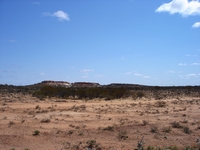
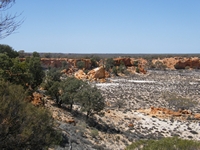
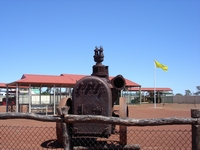
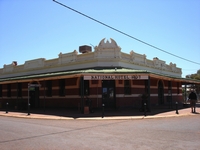
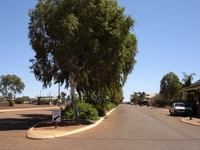
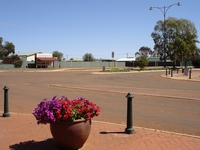
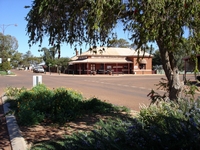
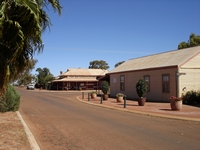
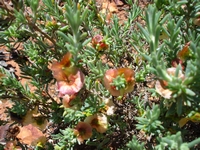
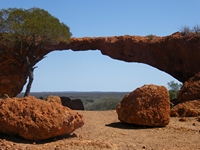
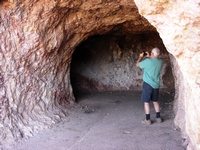
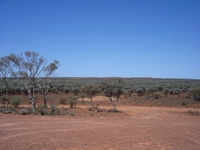
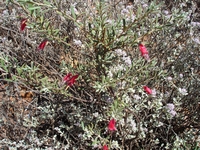
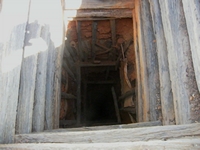
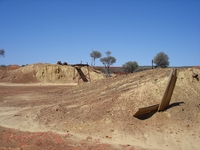
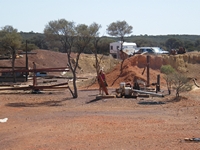
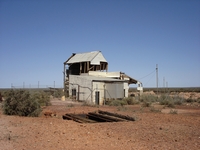
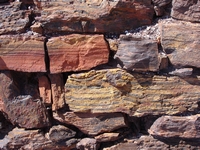
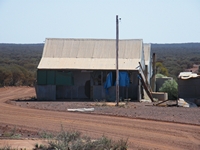
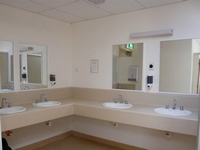
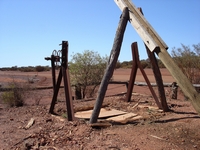
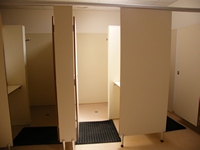
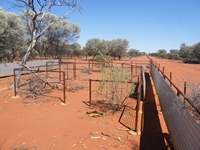
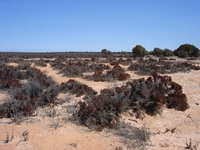
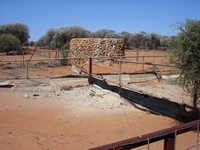
Approaching Sandstone, we followed the Heritage Trail which loops to the south of the town.
Wildflowers were starting to colour this barren land.
People in the town were far more welcoming and a number of them gave me advice about where to stay and put me in touch with the right
people. The local golf club was providing caravan sites, with a donation for the showers requested while the caravan park was
out of operation.
Looking south from the top of the Brewery rock, more old gold mining sites were visible with the near one being a small hand dug mine
and the slag heaps near the horizon indicate a bigger mining enterprise.
The Brewery was established in 1907 by Irishman JV Kearney, the Brewery catered for the drinking needs of the local people for many
years. Water was pumped to equipment on the upper level for brewing and then stored in the cellars below which, being carved in solid
rock, ensured that he beer was kept cool. I walked over the top of the rock, where holes have been made through the cave roof.
We passed an abandoned mine site with numerous diggings.
Copyright (C) 2013 AustraliaSoMuchtoSee.com. All rights reserved
Nearing the town of Sandstone there were colourful orange and white breakaways. The Peter Denney Lookout not far from Sandstone
is a roadside parking area at the edge of a plateau, with a semicircle of breakaway ridges before the lower plain to the south of
the road. It was named after a former Shire President of Sandstone.
This was once pastoral station country and it is fenced, although we didn’t see any livestock. Mining predominates now.
Leinster is a modern mining town where almost everything is owned by BHP. BHP does nothing to attract tourists, and even
the caravan park was closed for renovations and was being filled with accommodation donga at the time of our visit. It has subsequently
re-opened with some tourist places available.
London Bridge - The Sandstone Arch is a major feature at Sandstone, and is a little further along the heritage trail. This unique
structure consists of weathered basalt and is believed to be about 350 million years old. It was once possible to drive a horse
and buggy across the arch and photos of this can be seen in the Sandstone Museum. As can be seen by the large boulders under
the arch, considerable erosion has taken place since and it is not considered safe to even walk on it now.
This all looked like ‘pick and shovel’ mining, although a name with a date marked on the cement where an engine had been mounted was
the somewhat recent date of Feb 1984.
This mine shaft has been shored up with timber, which is now starting to crumble.
Next feature on the trail was the site of the State Battery. First established at Paynesville, the State Battery was moved to
a site west of here in 1904 and was finally shifted to this site in 1925. 135,809 tons of ore were treated at the Battery producing
115,787 ounces of gold bullion. The Battery closed in 1982.
Heading towards the town, we stopped at Contradiction Well which was the first town water supply and in fact predates the establishment
of the Sandstone townsite. It was located on Menzies Road for prospectors, Cobb & Co coaches and travellers in the area to use
for horses and livestock.
By 1919 the population of the town had dwindled to 200 people. When we were there in 2008, the population of the entire Shire
of 28,218 square kilometres was 116 people. There were fifteen pupils attending the Primary School.
While looking at the displays in the Shire building, look for the trial transcript and background of “A Perfect Murder”.
In 1929 Arthur Upfield, Australia's premier crime writer, plotted a perfect murder for his novel The Sands of Windee. To his
horror, one of his friends, stockman Snowy Rowles, put the scheme into deadly effect even before the book was published. The result
was Western Australia's most sensational murder trial of the 1930s.
Lake Mason is a 58 kilometre long clay pan which has been dry for over thirty years and is within a group of stations taken over by
the Government as a conservation area. Most buildings and stock watering points have been removed from these stations.
However there is a Manager on site at Lake Mason, where a former hotel was relocated from Sandstone eighty years ago to be used as
the station homestead. The walls and ceilings are of pressed tin. A cool room made from brush which is cooled by trickling water
is alongside the house comfortable living on for hot days; a giant Coolgardie safe for the station people.




























